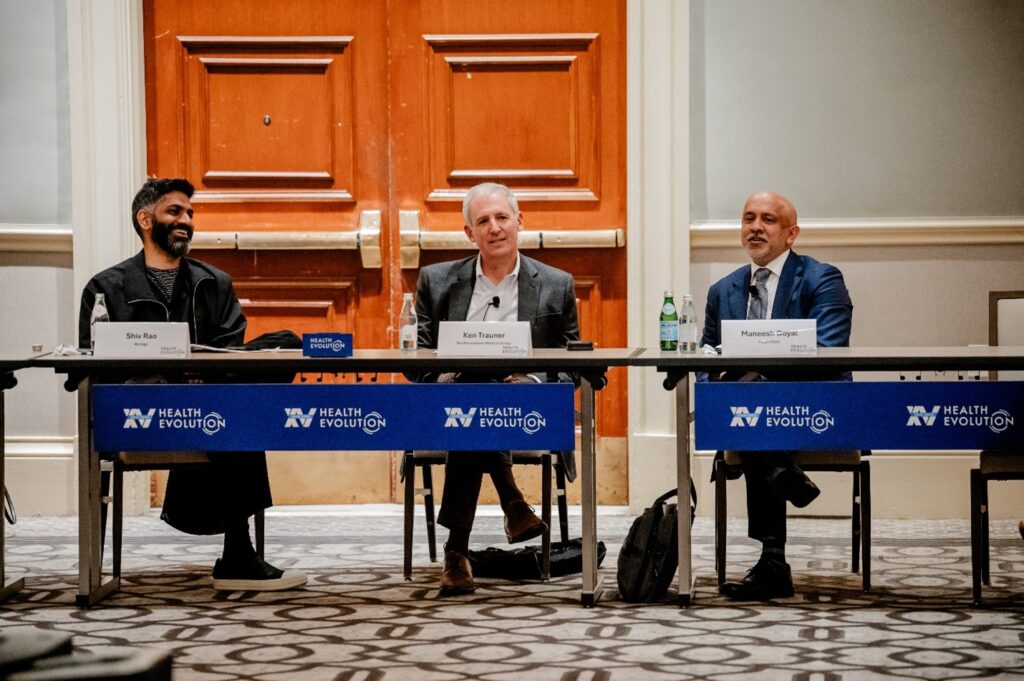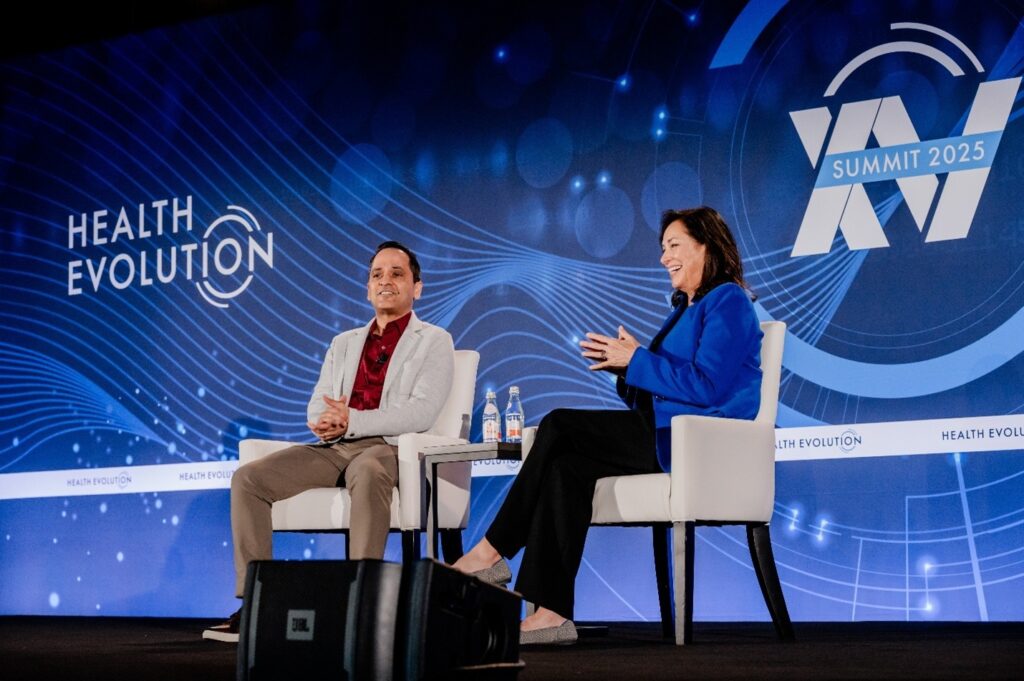For 15 years, Health Evolution Summit has convened the most influential leaders in health care to address the industry’s most pressing challenges and collaborate on opportunities to drive the industry forward. To kick off our 2025 Summit, we expanded on Summit’s renowned discussions with our first-ever Summit Intensive, where cross-industry executives explored the transformative power of artificial intelligence (AI) in health care and discussed how they’re adapting their strategies and organizations to lead through the AI revolution.
Throughout the Intensive, leaders underscored the imperative of maintaining a strategic and innovative mindset as they explore and embrace the intersection of AI and health care. The Intensive’s Big Discussions highlighted practical approaches to help leaders navigate this rapidly evolving environment and featured expert insights from discussion leaders:
- Sandeep Dadlani, Chief Digital and Technology Officer, UnitedHealth Group
- Karen Desalvo, MD, Chief Health Officer, Google; former Assistant Secretary for Health, HHS
- John D. Halamka, MD, President, Mayo Clinic Platform
- Shiv Rao, MD, Founder & CEO, Abridge
- Suchi Saria, Founder & CEO, Bayesian Health; Director of the Machine Learning, AI and Healthcare Lab, Johns Hopkins University
- Mario Schlosser, Co-Founder & Chief Technology Officer, Oscar Health
Read on to learn how leading executives are using AI to transform health care.
Leading Through the AI Revolution

To open the Summit Intensive, Saria moderated a Big Discussion on “Leading Through the AI Revolution” with Halamka, Rao, and Schlosser. They centered the conversation around three key takeaways:
1. AI adoption: The question is not ‘if’ but ‘when’
In our current health care ecosystem, stakeholders are more willing to engage with AI across the board. This shifting openness gives leaders an opportunity to redesign how health care organizations work with AI at the core—and find ways to move faster as an ecosystem to accelerate adoption and drive positive change.
“In fields like AI where we are bringing on brand new ideas, we need the ability to question the status quo. We need the ability to do first-principle reasoning and the courage to say, ‘this makes sense and here’s why,’ and then bring other people along. That’s the only way we bring about very meaningful, significant change,” Saria said.
As changemakers continue challenging the status quo and exploring new use cases for AI in health care, industry leaders will gain a clearer understanding of where they can use AI most effectively.
While some leaders are concerned AI could change or replace health care roles, Rao noted that AI should be seen as a technology that enables and strengthens interfaces that help humans do their jobs better.
“Health care has adopted AI faster than any other industry,” Rao said. “And I think part of the reason is that we’ve all recognized that AI can do tasks for us.”
Despite the expanding capabilities of AI tools, Schlosser acknowledged there are still limiting factors, including elements of patient engagement and emotional intelligence-based tasks. “Encouragement and motivation will probably remain human tasks for quite some time,” Schlosser said.
2. Trust plays a key role in AI advancement
Trust has the potential to accelerate—or stall—AI adoption. “We all understand that the stakes are high. Whenever we introduce technology, we need to introduce it responsibly, and in order to drive adoption, we have to build trust,” Saria said.
Building and validating effective AI models takes time and requires robust partnerships. Leaders must work to build a foundation of trust among those building AI tools, those testing and validating the tools, and those using the tools.
A key factor in building that trust is demonstrating a range of scalable, reliable use cases. For example, when partnering with health systems, AI companies “have to demonstrate that we can scale across all the different care settings, specialties, and languages,” Rao said.
Saria noted that, “historically, federal agencies have been the go-to source for providing endorsement and certification” of which technologies health care leaders could trust. However, the regulatory process can slow down innovation and create challenges and limitations in implementation. According to Saria, a key challenge in public-private partnerships is striking a balance to provide oversight that ensures responsible deployment without stifling progress.
To advance this work, “public-private partnerships must come together to assess risks and provide guidelines and guardrails,” Halamka said.
3. Top-down leadership will encourage innovation and engagement
To maximize AI’s potential in health care, leaders must foster a culture that promotes innovation, engagement, and collaboration across the health care ecosystem. C-suite leaders who model this culture can inspire others to embrace AI and work together to ensure AI tools are both safe and impactful.
For example, executives must work to advance data sharing across the industry to support AI development and validation, the discussion leaders said. “We need to view this as public good and agree to reduce psychological barriers against data sharing, which we’re starting to do,” Halamka said.
Executives also should involve staff throughout their organizations to test and integrate AI tools into their work, as creating an AI-proficient workforce positions organizations to leverage AI effectively and optimize workflows and processes.
Leading through the AI revolution may seem daunting at times, but the best path forward is for leaders to “get involved, start asking, start integrating, start partnering, learn from mistakes, and learn from peers,” Saria said.
Intensive Brass Tacks Breakout Discussions

Following the opening Big Discussion, executives participated in collaborative and intimate Brass Tacks breakout sessions to discuss top-of-mind issues with leaders at the forefront of AI and health care. Here’s an inside look at some of the topics and leaders featured in our inaugural Intensive Brass Tacks Discussions:
Fast Tracking GenAI: Strategies for Aligning Your Enterprise for Speed | Hosted by Deloitte
Discussion leaders:
- Bill Fera, Life Sciences and Health Care GenAI Leader and Principal, Deloitte
- Brian Anderson, CEO, Coalition for Health AI
- Cris Ross, Senior Advisor, Insight Partners; Board Director, CaringBridge; former Chief Information Officer, Mayo Clinic
- Phoebe Yang, Board Director of GE HealthCare, Doximity, CommonSpirit Health; former General Manager, Amazon Web Services
Cracking the AI Code: Finding the Right Strategy for Your Health System | Hosted by SmarterDx
Discussion leaders:
- Michael Gao, Founder & CEO, SmarterDx
- Sam Bagchi, EVP & Chief Clinical Officer, CHRISTUS
- Rafael Torres, Chief Quality Officer, White Plains Hospital
- Kathleen Silard, President & CEO, Stamford Health System
Patients at the Center: Reimagining Care Delivery, Experience, & Engagement with AI | Hosted by Mytonomy
Discussion leaders:
- Vinay Bhargava, President and Co-Founder, Mytonomy
- Anjali Kataria, Co-Founder & CEO, Mytonomy
- Debe Gash, CIO, Hackensack Meridian Health
- Steve Miff, President & CEO, Parkland Center for Clinical Innovation
Unlocking Value: The Business Case for Generative AI in Health Care | Hosted by Abridge
Discussion leaders:
- Shiv Rao, Founder & CEO, Abridge
- Maneesh Goyal, Chief Operating Officer, Mayo Clinic Platform
- Ken Trauner, Chief Innovation Officer, The Permanente Medical Group
Trust: The Cornerstone of AI’s Bridge Across Health Care | Hosted by KPMG
Discussion leaders:
- Ash Shehata, Partner Global Healthcare Center of Excellence, KPMG
- Anaeze C. Offodile II, EVP & Chief Strategy Officer, Memorial Sloan Kettering Cancer Center
- Jodi Daniel, Partner, Crowell & Moring
- Seema Verma, EVP & GM, Oracle Health and Life Science; Former Administrator, Centers for Medicare and Medicaid Services
Consumers at the Forefront: Real Opportunities to Transform Engagement & Experience

In our closing Big Discussion of the Summit Intensive, DeSalvo and Dadlani led a conversation focused on putting “consumers at the forefront” of AI in health care. They outlined three focus areas to help leaders transform consumer engagement and experience:
1. Easing consumer pain points
As leaders evaluate strategies to leverage AI, they should identify opportunities to ease consumer pain points. To identify the most pressing pain points, Dadlani recommends analyzing data to understand the concerns consumers raise during interactions.
Many consumers do not have a comprehensive understanding of the health care system and do not always know where to direct their questions or how to find certain information. However, leaders could deploy AI tools to help. For example, “we’re learning that large language models are really good at taking complicated questions and mapping out answers in paragraph form,” DeSalvo said.
2. Personalizing human-AI interactions
Leaders also should focus on how they can use AI advancements to personalize interactions with consumers, especially in ways that can reduce friction consumers often face when navigating health care. For example, using AI tools that remember users and build on their interactions and responses over time can ensure consumers do not need to repeat themselves each time they interact with an organization.
A more customized experience can make consumers feel as though systems and products are tailored to meet their needs, which can help drive loyalty and facilitate positive interactions. “That is what people want,” DeSalvo said. “They don’t want the general pamphlet on diabetes—they want to actually know more about what it means for them.”
3. Scaling through governance and leadership
According to Dadlani, AI governance and leadership is often a process of trial and error. To understand what is working and what is not, leaders should partner with employees and consumers to identify real-world use cases across their enterprise. “The real use cases are on the front lines,” Dadlani said. “We do not think of the right use cases in conference rooms.”
To ensure AI tools are effective and impactful, leaders should consistently evaluate use cases and make adjustments to improve outcomes.
“If you don’t do governance and leadership right, you can’t be successful,” DeSalvo said.
Leaders need to partner with consumers in ways that can enable widespread adoption of AI that creates seamless and effective experiences for consumers and maximizes AI’s impact.










